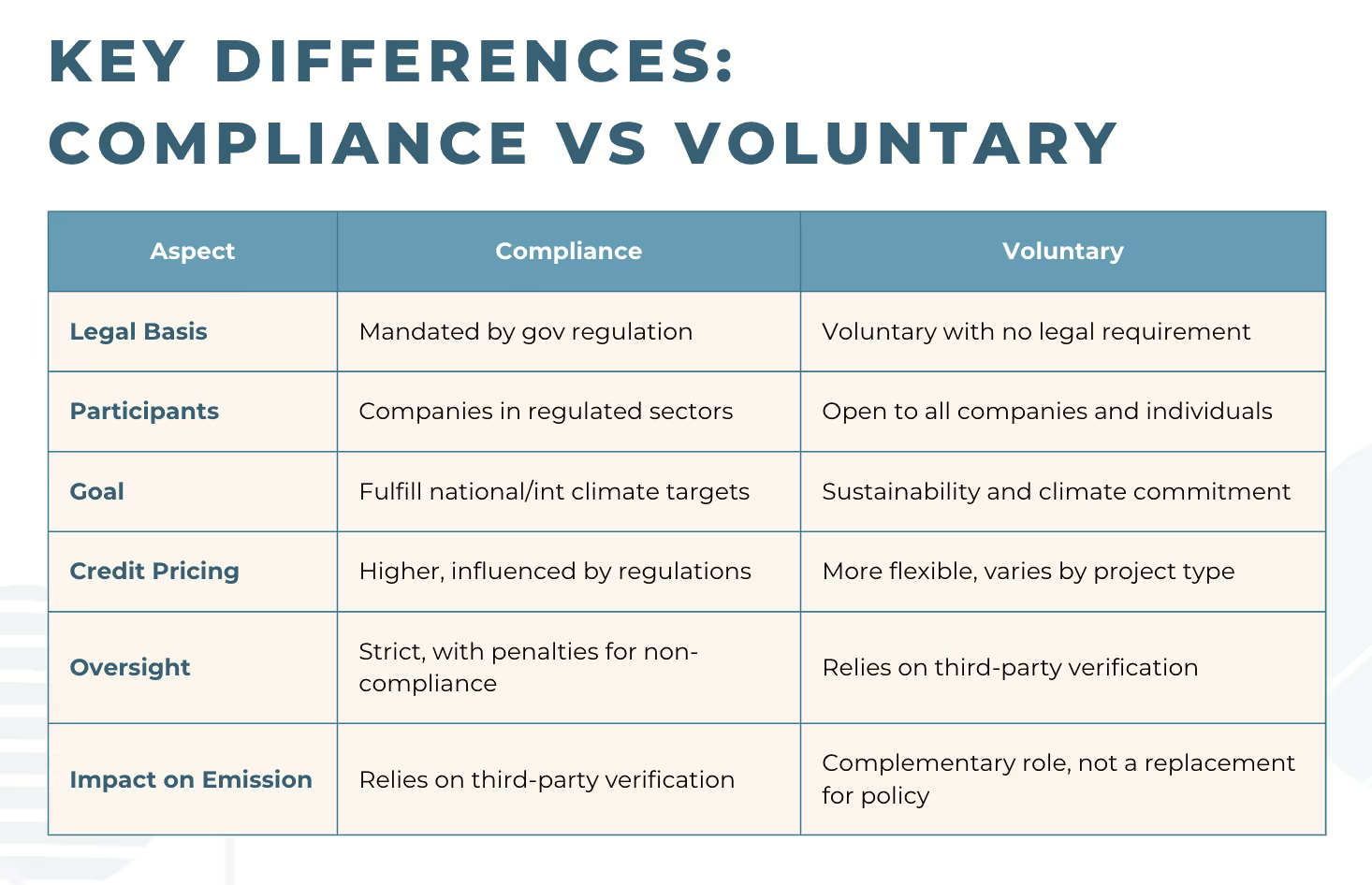
Product walkthrough, trial, POCs, enterprise offering, support and more. Speak with one of our specialists.


Product walkthrough, trial, POCs, enterprise offering, support and more. Speak with one of our specialists.

Policy and industry News

In the global effort to combat climate change, carbon markets have become an increasingly important mechanism. Though the term may sound technical, the basic concept is quite straightforward: assigning an economic value to carbon emissions. Through these markets, every one ton of carbon dioxide (CO₂) or other greenhouse gas (GHG) emissions reduced or removed from the atmosphere can be converted into a "carbon credit" that can be traded.
Today, carbon markets are divided into two main schemes: compliance markets mandated by regulations, and voluntary markets led by businesses and individuals taking climate action on their own terms. While both play important roles, their objectives, mechanisms, and impacts on businesses and the environment can be very different.
Let's dive deeper into how these markets work, what their strengths and challenges are, and how each contributes to global emissions reductions.
Carbon markets are a system or platforms where businesses and individuals can trade carbon credits—each representing the reduction or elimination of one metric ton of carbon dioxide or its greenhouse gas equivalent. By putting a price on emissions, the market incentivizes industries to be more mindful of their carbon output and to invest in cleaner, more sustainable solutions.
Depending on the regulatory framework and intent behind participation, carbon markets are generally divided into two main types, which are:
Compliance "Mandatory" Carbon Markets
Compliance carbon markets operate under government regulations. This means that companies in certain sectors are legally required to reduce their emissions in line with national or international targets.
A notable example is the European Union Emissions Trading System (EU ETS), which sets emissions limits for sectors such as power generation, heavy manufacturing, and aviation. If a company emits more than its allowed limit, it must buy credits from other companies that have emitted less. This system is known as "cap-and-trade."
Compliance markets are distinguished by their legal enforceability. Participation is mandated by government policies, and non-compliance can result in financial or administrative consequences. These markets often apply to industries with large carbon footprints, such as energy, manufacturing, or aviation.
Voluntary Carbon Markets
In contrast, voluntary carbon markets are driven by proactive commitment rather than legal obligation. Here, no government regulations force companies or individuals to purchase carbon credits. Yet many choose to do so voluntarily to meet sustainability goals, achieve net-zero emissions, or demonstrate corporate social responsibility (CSR).
Carbon credits in voluntary markets usually come from projects such as reforestation, mangrove conservation, renewable energy installations, or methane capture from landfills.
Because they are not government-regulated, the credibility of these projects is essential. Independent organizations like the Verified Carbon Standard (VCS) and Gold Standard play a crucial role in verifying and ensuring the quality of credits traded in voluntary markets.
Let's break down the main distinctions between these two types of markets:

Pros:
Challenges:
Strengths:
Weaknesses:
Despite their different approaches, compliance and voluntary markets are complementary. Compliance markets lay the foundation through legal enforcement, ensuring that high-emission sectors carry their weight. Voluntary markets, on the other hand, create space for quicker, more innovative action, often beyond the scope of government policy.
In Indonesia, for example, voluntary markets offer a way for businesses—from startups to large corporations—to participate in the low-carbon transition, even before national regulations catch up. One such platform is IDXCarbon, a voluntary carbon exchange launched by the Indonesia Stock Exchange (IDX) to facilitate transparent and credible carbon trading.
With increasing climate pressures and growing net-zero commitments, both compliance and voluntary carbon markets are expected to expand rapidly. Governments will likely broaden the scope of sectors subject to cap-and-trade systems. Simultaneously, more businesses will see strategic value in participating in voluntary markets for brand, sustainability, and risk management reasons.
Technological innovation is redefining the future of carbon markets. Blockchain adds transparency and prevents credit duplication, while advanced monitoring tools help verify the actual environmental impact of carbon offset projects. One such innovation is CarbonAtlas by Jejakin, a digital platform designed to monitor Nature-based Solutions projects, including carbon projects with precision.
By combining satellite imagery and drone-based aerial monitoring, CarbonAtlas allows stakeholders to track tree planting progress, observe land-use changes, and estimate carbon sequestration in near real-time. This integration not only enhances transparency and accountability but also builds trust among investors, partners, and the public—ensuring that carbon credits truly represent tangible environmental benefits.
Carbon markets aren't just economic tools, they reflect our collective effort to repair the impact we've had on the planet. Whether driven by regulation or voluntary action, both market types play vital roles in fostering meaningful change.
For businesses, understanding the difference between compliance and voluntary carbon markets is the first step in building a concrete sustainability strategy. For policymakers, combining both systems provides a powerful toolkit for designing effective, inclusive climate policies






















Jejakin’s green programs combine high-tech monitoring, biodiversity restoration, and community-led initiatives to deliver powerful, sustainable change across ecosystems.








